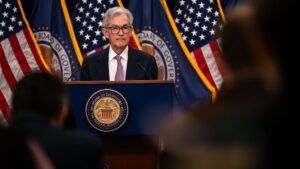Understanding the FED’s Cautious Approach: Insights from the December Meeting
At the December meeting of the Federal Reserve, a wave of concern echoed through the discussions among the officials regarding the current landscape of inflation and the potential ramifications of President-elect Donald Trump’s impending policy changes. The minutes from this crucial meeting, recently made public, suggest that the Fed is poised to proceed with caution when it comes to further interest rate cuts, navigating through a fog of uncertainty.
While the Federal Open Market Committee (FOMC) refrained from naming Trump directly, the minutes highlighted several mentions regarding how shifts in immigration and trade policy could considerably influence the U.S. economy. Since Trump’s election victory, he has laid out bold plans for imposing aggressive tariffs on nations like China, Mexico, and Canada, along with ambitions for deregulation and mass deportations. However, the uncertainty surrounding the specifics of these policies has prompted a careful approach from the Fed.
Inflation Concerns and Economic Stability
"Almost all participants judged that upside risks to the inflation outlook had increased," the minutes reported, reflecting growing concerns stemming from recently stronger-than-expected inflation data. The central bank’s efforts to manage inflation—to keep it within a desirable range—are of paramount importance. As strategic investors, understanding the Fed’s interpretation of these risks can greatly inform your financial decisions.
At the meeting, the FOMC voted to adjust the benchmark borrowing rate to a target range of 4.25%-4.5%. However, members revised their forecast for future rate cuts down to two from four by 2025, suggesting a shift in anticipated monetary policy. This reduction illustrates the Fed’s readiness to recalibrate its strategies based on evolving economic indicators.
The Current Economic Landscape
The prevailing economic atmosphere includes several positive indicators: inflation rates remain above the Fed’s desired 2% threshold, consumer spending is robust, and the job market continues to show resilience. Nevertheless, with growth in Gross Domestic Product (GDP) surpassing trend expectations through 2024, many members expressed the view that it’s crucial to proceed with caution. According to the minutes, “the policy rate was now significantly closer to its neutral value than when the Committee commenced policy easing in September.”
What does this mean for investors? Patience could prove to be a valuable asset as the Fed assesses the emerging outlook for economic activity and inflation. With indications that core inflation was running at a 2.4% rate in November—2.8% when including food and energy—market conditions hint at possible adjustments ahead.
Navigating the Uncertainty
Fed Chair Jerome Powell compared the current economic environment to “driving on a foggy night,” underscoring the need for a slower, more measured approach to policy decision-making. The Fed is not operating on a fixed timetable for future actions; rather, it is collecting data and responding accordingly.
With expectations of two additional rate cuts in 2026 possibly tapering to a long-term federal funds rate around 3%, the implications for investors are clear. A gradual progression toward neutrality in policy could potentially shape investment strategies for years to come.
Conclusion: The Investor’s Perspective
For members of the Extreme Investor Network, it’s imperative to stay abreast of how the Federal Reserve’s movements can impact both the broader market and individual investment strategies. With uncertainty in policy direction, focus should pivot to emerging economic data and how it intersects with inflation expectations, trade policies, and consumer behavior.
As we navigate these turbulent waters together, leveraging insights like these can empower you to make informed investment decisions. Use the current economic climate to your advantage by anticipating Federal Reserve maneuvers and aligning your portfolio accordingly. Remember, in finance—as in life—the key is always to adapt to changing circumstances and thrive in uncertainty.

